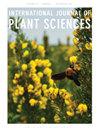Shade Tolerance and the Relationship between Herbivory and Light Availability
IF 1.5
3区 生物学
Q3 PLANT SCIENCES
引用次数: 0
Abstract
Premise of research. Herbivore damage is generally higher in the sun than in the shade. The influence of shade tolerance on herbivory has been mainly related to the fact that light-demanding plant species show lower defense investments—and hence higher herbivory—than shade-tolerant species. The pattern of increased herbivory with increasing light availability may take different forms, depending on the drivers of herbivore damage across the light gradient: (1) herbivory pressure alone, (2) herbivory pressure together with plant resistance associated with shade tolerance, or (3) the two drivers seen in scenario 2 added to a differential effect of light availability on plant resistance depending on shade tolerance. Elucidating the specific patterns behind the general pattern of increased herbivory with increasing light availability may contribute to understanding and aid prediction of herbivory patterns in forest communities under natural or anthropogenic disturbance. Methodology. In a field study with 15 tree species distributed across the light gradient in a temperate rainforest (1.6%–26.2% canopy openness), we evaluated the relationship between canopy openness and seedling herbivory, with 755 seedlings surveyed for herbivore damage. Specifically, we evaluated the consistency between the observed herbivory–canopy openness relationship and the three scenarios described above. Pivotal results. We found steeper slopes for the herbivory–canopy openness relationship in tree species with lower shade tolerance; that is, we verified scenario 3. Conclusions. Shade tolerance determined the slope of the herbivory–canopy openness relationship across the light gradient. This finding expands our understanding of the recognized influence of shade tolerance on the interplay between herbivory and the light environment.植物耐荫性及其光效与草食性的关系
研究的前提。草食动物在阳光下的伤害通常比在阴凉处要高。耐荫性对草食性的影响主要与这样一个事实有关,即需要光的植物物种比耐荫的物种表现出更低的防御投资,从而更高的草食性。随着光有效性的提高,草食性增加的模式可能采取不同的形式,这取决于在光梯度上草食动物损害的驱动因素:(1)单独的草食压力,(2)草食压力加上与遮荫耐受性相关的植物抗性,或(3)场景2中看到的两个驱动因素增加了光有效性对植物抗性的差异影响,这取决于遮荫耐受性。阐明随光效增加而草食增加的总体模式背后的特定模式,有助于理解和预测自然或人为干扰下森林群落的草食模式。方法。在温带热带雨林(冠层开阔度为1.6% ~ 26.2%)不同光照梯度的15种树种中,利用755株幼苗进行了草食损害调查,分析了冠层开阔度与幼苗食草性的关系。具体而言,我们评估了观测到的草食-冠层开放度关系与上述三种情景之间的一致性。关键的结果。绿荫耐受性较低的树种的草食-冠层开度关系斜率较大;也就是说,我们验证了场景3。结论。遮荫耐受性决定了草食-冠层开放度关系在光梯度上的斜率。这一发现扩大了我们对草食和光环境相互作用中遮荫耐受性的认识。
本文章由计算机程序翻译,如有差异,请以英文原文为准。
求助全文
约1分钟内获得全文
求助全文
来源期刊
CiteScore
4.50
自引率
4.30%
发文量
65
审稿时长
6-12 weeks
期刊介绍:
The International Journal of Plant Sciences has a distinguished history of publishing research in the plant sciences since 1875. IJPS presents high quality, original, peer-reviewed research from laboratories around the world in all areas of the plant sciences. Topics covered range from genetics and genomics, developmental and cell biology, biochemistry and physiology, to morphology and anatomy, systematics, evolution, paleobotany, plant-microbe interactions, and ecology. IJPS does NOT publish papers on agriculture or crop improvement. In addition to full-length research papers, IJPS publishes review articles, including the open access Coulter Reviews, rapid communications, and perspectives. IJPS welcomes contributions that present evaluations and new perspectives on areas of current interest in plant biology. IJPS publishes nine issues per year and regularly features special issues on topics of particular interest, including new and exciting research originally presented at major botanical conferences.

 求助内容:
求助内容: 应助结果提醒方式:
应助结果提醒方式:


